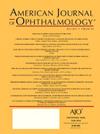Incidence and Prevalence of Uveitis and Associated Ocular Complications in the United States TriNetX Database
IF 4.1
1区 医学
Q1 OPHTHALMOLOGY
引用次数: 0
Abstract
Objective
To analyze the demographics, immunosuppressant use, associated systemic diseases, ocular comorbidities, and incidence and prevalence of uveitis and associated low vision using the United States TriNetX database from 2013-2023.
Design
Retrospective cross-sectional and trend study.
Participants
Subjects with uveitis in the TriNetX database.
Methods
Subjects with uveitis were identified with International Classification for Disease codes and then divided into anatomic subtypes based on the diagnosis. Incidence and prevalence data were collected from 2013-2023. Additional data collected included demographics, use of systemic immunosuppressive medications, presence of an associated systemic disease, and associated ocular complications.
Main Outcome Measures
The primary outcomes were the incidence and prevalence of uveitis (annual and cumulative) with additional analysis by anatomic subtype. Secondary outcomes were the incidence and prevalence of low vision (annual and cumulative).
Results
Out of the 109,026,851 subjects in the database, 278,333 (0.26%) had a diagnosis of uveitis. The mean age was 56 years (Standard Deviation = 21, 95% Confidence Interval (CI) 55.9-56.1), and the majority were female (n = 149,186; 53.6%, 95% CI 53.4%-53.8%) and white (n = 150,578; 54.1%, 95% CI 53.9%-54.3%). Anterior uveitis was the most common subtype (n = 209,073, 75.1%). Oral prednisone (n = 62,834; 22.6%, 95% CI 22.5%-22.8%) was the most used immunosuppressant and methotrexate (n = 15,817; 5.7%, 95% CI 5.6%-5.8%) was the most prevalent corticosteroid-sparing immunosuppressive agent. Inflammatory spondyloarthropathies (n = 18,372; 6.6%, 95% CI 6.5%-6.7%) were the most frequently associated systemic disease. The cumulative incidence and prevalence of uveitis from 2013-2023 were 212.5 and 260.8 per 100,000 persons, respectively.
Conclusions
This study represents one of the largest uveitis populations analyzed in the United States, revealing a rising incidence of all uveitis subtypes and an increase in low vision among affected patients over the past decade in the database. Prospective studies are needed to identify the factors driving these trends and to develop strategies to prevent vision loss and ocular complications in uveitis patients.
美国TriNetX数据库中葡萄膜炎及相关眼部并发症的发病率和患病率。
目的:利用美国TriNetX数据库分析2013-2023年的人口统计学、免疫抑制剂使用、相关系统性疾病、眼部合并症、葡萄膜炎和相关低视力的发病率和流行率。设计:回顾性横断面和趋势研究参与者:TriNetX数据库中的葡萄膜炎患者方法:使用国际疾病分类代码对葡萄膜炎患者进行识别,然后根据诊断将其分为解剖学亚型。收集2013-2023年的发病率和流行率数据。收集的其他数据包括人口统计数据、全身性免疫抑制药物的使用、相关全身性疾病的存在以及相关的眼部并发症。主要结局指标:主要结局是葡萄膜炎的发生率和患病率(年度和累积),并对解剖亚型进行了额外的分析。次要结果是低视力的发生率和流行率(年度和累积)。结果:在数据库中的109,026,851名受试者中,278,333名(0.26%)被诊断为葡萄膜炎。平均年龄56岁(标准差=21,95%可信区间(CI) 55.9-56.1),以女性居多(n=149,186;53.6%, 95% CI 53.4-53.8%)和白色(n=150,578;54.1%, 95% ci 53.9-54.3%)。前葡萄膜炎是最常见的亚型(n=209,073, 75.1%)。口服强的松(n=62,834;22.6%, 95% CI 22.5-22.8%)是使用最多的免疫抑制剂和甲氨蝶呤(n=15,817;5.7%, 95% CI 5.6-5.8%)是最普遍的皮质类固醇免疫抑制剂。炎性关节病(n=18,372;6.6% (95% CI 6.5-6.7%)是最常见的全身性疾病。2013-2023年葡萄膜炎的累计发病率和患病率分别为212.5 / 10万人和260.8 / 10万人。结论:这项研究代表了美国最大的葡萄膜炎人群之一,揭示了在过去十年中,所有葡萄膜炎亚型的发病率都在上升,受影响患者的低视力也在增加。需要前瞻性研究来确定推动这些趋势的因素,并制定预防葡萄膜炎患者视力丧失和眼部并发症的策略。
本文章由计算机程序翻译,如有差异,请以英文原文为准。
求助全文
约1分钟内获得全文
求助全文
来源期刊
CiteScore
9.20
自引率
7.10%
发文量
406
审稿时长
36 days
期刊介绍:
The American Journal of Ophthalmology is a peer-reviewed, scientific publication that welcomes the submission of original, previously unpublished manuscripts directed to ophthalmologists and visual science specialists describing clinical investigations, clinical observations, and clinically relevant laboratory investigations. Published monthly since 1884, the full text of the American Journal of Ophthalmology and supplementary material are also presented online at www.AJO.com and on ScienceDirect.
The American Journal of Ophthalmology publishes Full-Length Articles, Perspectives, Editorials, Correspondences, Books Reports and Announcements. Brief Reports and Case Reports are no longer published. We recommend submitting Brief Reports and Case Reports to our companion publication, the American Journal of Ophthalmology Case Reports.
Manuscripts are accepted with the understanding that they have not been and will not be published elsewhere substantially in any format, and that there are no ethical problems with the content or data collection. Authors may be requested to produce the data upon which the manuscript is based and to answer expeditiously any questions about the manuscript or its authors.

 求助内容:
求助内容: 应助结果提醒方式:
应助结果提醒方式:


